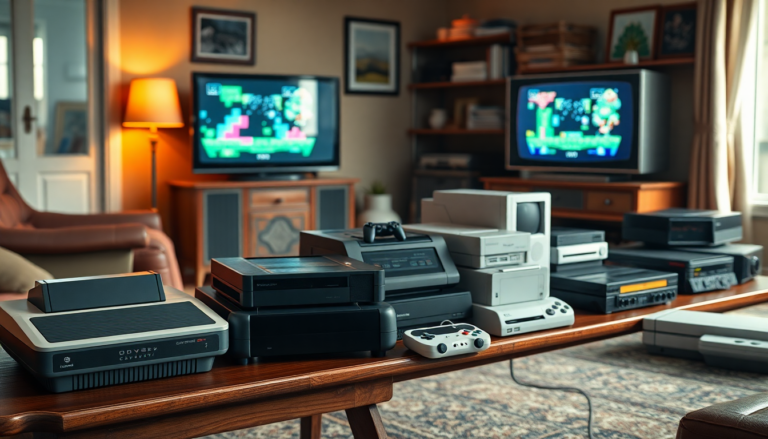Argomenti trattati
The beginnings of video game consoles
The story of video game consoles, both home and handheld, began in the 1970s. The first home console that allowed users to play games on their television was the Magnavox Odyssey, which debuted in 1972. This groundbreaking device was the brainchild of Ralph H. Baer, who initially envisioned the concept in 1966. Handheld consoles also have their roots in this era, emerging from electro-mechanical games that utilized mechanical controls and light-emitting diodes (LED) for visual representation. Over time, these handheld games transitioned to electronic components, leading to devices like the Microvision and Nintendo’s Game & Watch series, which became the first true handheld video game consoles.
Generational progress in home consoles
Since their inception, home gaming consoles have evolved through several technology cycles, often referred to as generations. Each generation typically spans roughly five years, during which leading console manufacturers release devices with similar specifications. Handheld consoles usually follow the same generational trends as their home counterparts. In the early years, companies like Atari and Sega dominated the market, but today, the landscape is primarily shaped by three major players: Nintendo, Sony, and Microsoft. While the handheld market has diminished due to the rise of mobile gaming since the late 2000s, Nintendo remains the primary manufacturer in this sector.
The rise of arcade and home gaming
The roots of video gaming can be traced back to the 1950s, when the first video games were created on mainframe computers. These early games, which often featured text-only displays, included simple concepts like Tic Tac Toe and Nim. As technology advanced, more sophisticated displays became available, paving the way for titles like Spacewar! in 1962, which directly inspired Nolan Bushnell and Ted Dabney to develop Computer Space in 1971, recognized as the first arcade game. This evolution set the stage for the burgeoning video game industry.
The inception of home consoles
Ralph H. Baer’s vision continued to shape the industry when he created the prototype known as the “Brown Box” at Sanders Associates in 1966. This device could connect to a standard television and offered a limited selection of games, including table tennis and a light gun game. After patenting the unit, Baer licensed the technology to Magnavox, leading to the production of the Odyssey in 1972. This console initially shipped with game cards that altered circuitry but did not contain programmed games. Following the Odyssey’s success, Atari was inspired to develop Pong, which debuted in 1972 and quickly became a cultural phenomenon.
Handheld gaming’s emergence
The origins of handheld gaming devices can be traced back to the electronic games of the 1970s and early 1980s. These devices, often resembling calculators, were limited to built-in games. The first notable handheld electronic game was released by Mattel in 1977, marking the beginning of a lucrative market. As the popularity of these electronic games soared, Ralph Baer’s Simon, produced by Milton Bradley in 1978, further solidified the handheld gaming trend. The transition to handheld video games was marked by LCD technology, enabling a wider array of game options. Nintendo’s Game & Watch series, launched in 1980, set the stage for the release of the Game Boy in 1989, which would become a cornerstone of portable gaming.
Defining console generations
The timeline of video game consoles is often categorized into distinct generations, each marked by significant technological advancements. The first generation, which began with the Magnavox Odyssey, featured dedicated consoles with limited gameplay options. As the market evolved, the introduction of the game cartridge in the second generation allowed for greater game variety and accessibility. The Atari 2600 and Intellivision exemplified this shift, leading to a booming market during the late 1970s and early 1980s.
The impact of the video game crash
The video game industry faced significant challenges in the early 1980s, culminating in a major crash in 1983. The oversaturation of the market, coupled with a decline in quality titles, led to a loss of consumer confidence. However, this downturn paved the way for Nintendo’s entry into the North American market with the Nintendo Entertainment System (NES) in 1985, which revitalized the industry and established strict controls over game publishing.
Technological advancements in gaming
As the industry progressed into the 16-bit era during the fourth generation, consoles like the Sega Genesis and Super Nintendo Entertainment System (SNES) advanced graphics and audio capabilities, leading to intense competition. The introduction of CD-ROM technology during the fifth generation allowed for larger game content and sophisticated storytelling, as seen with the release of the Sony PlayStation, which revolutionized gaming with its vast library and innovative use of memory cards.
The modern gaming landscape
With the advent of the sixth and seventh generations, gaming technology continued to evolve. The PlayStation 2, Xbox, and GameCube shifted focus towards online connectivity and multimedia capabilities, while Nintendo explored innovative control schemes with the Wii. The introduction of smartphones further transformed the gaming landscape, creating new challenges for traditional consoles.
The future of gaming consoles
As we move into the ninth generation with the PlayStation 5 and Xbox Series X, the lines between consoles and personal computers blur. With advanced features like high-resolution graphics, SSD storage, and cloud gaming, the future of gaming promises to continue evolving rapidly. While handheld gaming faces competition from mobile devices, the potential for cross-platform play and cloud gaming offers exciting opportunities for developers and players alike.

